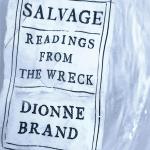Exposing the Violence of Empire in the Novels It Left Behind

Salvage: Readings From the Wreck
Dionne Brand
Farrar, Straus & Giroux
ISBN: 9780374614843
Dionne Brand is a poet, novelist and essayist who was born in Trinidad and moved to Canada in 1970. She seeks, across all her work, to interrupt history. Or, as she puts it in her new book, “Salvage: Readings From the Wreck,” describing how the fiction writer John Keene blows “life into the collapsed world of coloniality,” she exposes histories that have not previously come to the surface, finding traces that were of little importance to the white writers of England’s colonial past.
In “Salvage,” which Brand calls “an autobiography of the autobiography of reading,” she returns to some of the 18th- and 19th-century social-realist novels — “Vanity Fair,” “Jane Eyre,” “Robinson Crusoe” and “Mansfield Park” — that she read as a young person, along with more recent spinoffs such as Jean Rhys’s “Wide Sargasso Sea” and J.M. Coetzee’s “Foe.” Having been trained to read the classics as an Anglophile Commonwealth subject, first in the West Indies and then in Canada, Brand rereads them to recover the Black and Indigenous lives that English realism obscured.
It’s not that Black and Indigenous bodies are simply pushed aside in these novels; they’re kept in sight just long enough for their presence to underscore and intensify their absence. In short, Brand shows that learning to read English literature involved learning not to notice who, or what, was missing.
The most striking instance she discovers of her past misreading occurs when she returns to Thackeray’s “Vanity Fair.” She cites the Trinidadian historian and activist C.L.R. James, who wrote, in Brand’s paraphrase, “that Thackeray, not Marx, made him.” James meant by this that literature was always an “active, interested” part of the “imperializing project,” collaborating in colonialism’s disparaging of Blackness by relegating it to the margins of fiction. When Brand rereads “Vanity Fair,” she notes that Becky Sharp’s status as an aggrieved social misfit “gestured toward Blackness in this respect of wanting what one did not have and growing bitter without it.”
These are the kinds of details that made up the worlds of the realist novel, too. Brand’s key point is that the minutiae of white characters’ daily lives serve to conceal the unseen — unsalvaged — minutiae of the enslaved and Indigenous lives under imperial control. She makes her case forcefully in a chapter on Jane Austen’s “Mansfield Park.” The family in the novel derives income from a sugar plantation in Antigua, but we learn this only from a passage about procuring a horse for the heroine, Fanny Price, while Sir Thomas Bertram, the plantation's owner, is away in the colony. The horse carries a “freight” of information about the family’s slave-owning past that “we must nonetheless ignore,” Brand argues, “because our concern is for Fanny getting a horse.” This is how English realism works: The particulars of white daily life distract from, but never efface completely, the Black and Indigenous characters lurking at the margins, as so much literary flotsam.
Equally suggestive are moments in Brand’s book when she shows us how a passage ostensibly not about the violence of colonialism is in fact a barely conscious acknowledgment of it. Reading Charlotte Brontë’s “Jane Eyre,” for example, Brand stresses not only that it is a novel of “confinement and submission” for its white female characters, but that the wealth and luxury in the novel are “produced by the political economy of slavery,” including in the case of Jane Eyre herself, who attains financial independence when she inherits an estate in Madeira, a former sugar colony.
